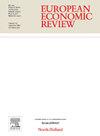全球公共产品、财政政策协调与世界经济福利
IF 2.8
2区 经济学
Q1 ECONOMICS
引用次数: 0
摘要
利用世界经济的两区域内生增长模型,研究了国家决策者之间的战略互动。扭曲的税收被用来资助国内的基础设施投资,并由一个全球基金为疫苗生产提供资源。虽然全球公共利益不是排他性的,但它在一定程度上是竞争性的。在财政封闭和财政开放两种情况下,对合作和不合作的最优税率进行了解析求解,并通过数值实验对合作的福利收益进行了评价。在合作的情况下,最优税率是高还是低,福利收益的大小取决于资本市场的一体化程度、支出组成部分之间是否存在直接的权衡,以及税基的性质。当健康税采取资本或财富税的形式时,在自给自足和财政开放的情况下,合作都是福利的改善,但在所有政策制度下,执行和征收成本可能会缩小税收的范围。本文章由计算机程序翻译,如有差异,请以英文原文为准。
Global public goods, fiscal policy coordination, and welfare in the world economy
A two-region endogenous growth model of the world economy with local and global public goods is used to study strategic interactions between national policymakers. Distortionary taxes are used to finance infrastructure investment at home and generate resources for vaccine production by a global fund. While the global public good is nonexcludable, it is partially rival. Optimal tax rates under cooperation and noncooperation are solved for analytically, under both financial autarky and openness, and numerical experiments are performed to evaluate the welfare gain from cooperation. Whether optimal levies are higher or lower under cooperation, and the magnitude of welfare gains, depend on the degree of integration of capital markets, the existence of a direct trade-off between expenditure components, and the nature of the tax base. When the health levy takes the form of a capital or wealth tax, cooperation is welfare-improving under both autarky and financial openness, but enforcement and collection costs may narrow the scope of taxation under all policy regimes.
求助全文
通过发布文献求助,成功后即可免费获取论文全文。
去求助
来源期刊

European Economic Review
ECONOMICS-
CiteScore
4.70
自引率
3.60%
发文量
170
期刊介绍:
The European Economic Review (EER) started publishing in 1969 as the first research journal specifically aiming to contribute to the development and application of economics as a science in Europe. As a broad-based professional and international journal, the EER welcomes submissions of applied and theoretical research papers in all fields of economics. The aim of the EER is to contribute to the development of the science of economics and its applications, as well as to improve communication between academic researchers, teachers and policy makers across the European continent and beyond.
 求助内容:
求助内容: 应助结果提醒方式:
应助结果提醒方式:


